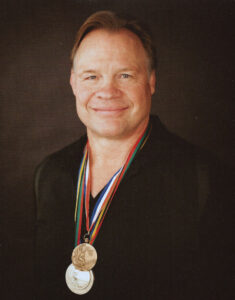From the St. Louis Park Magazine, January 2014, by Angela Johnson
Olympic fever is about to grip the nation, and one former St. Louis Park resident knows what it’s like to wrestle with that fever, literally. From 1986 to 1993, Dennis Koslowski lived in the Park and during that time, the champion wrestler made two Olympic appearances (and received a proclamation for his achievements from the City of St. Louis Park). During the 1988 Olympic Games in Seoul, Korea, Koslowski earned a bronze medal for Greco–Roman wrestling, followed by a silver medal in Barcelona in 1992. Today, Minnetonka resident Koslowski is a chiropractor incorporating his athletic expertise into the treatment of sports injuries.
Koslowski grew up in Webster, South Dakota, an area dubbed a wrestling hotbed and hometown to other champion wrestlers like Brock Lesnar, who became a professional wrestler and mixed martial artist. At Webster Junior High, Koslowski first discovered his wrestling abilities. “My gym teacher was also the wrestling coach,” says Koslowski. “He saw me tussle with my twin brother Duane, and recognized our natural talent. The coach encouraged us to join the wrestling team and I won the state championship in the 11 and 12–year–old division during my first year of competition.”
Koslowski notes his early success wasn’t necessarily a harbinger of things to come. “I was a late bloomer and never won another state championship in South Dakota,” he says. But the caliber of the brothers’ talent was enough to get them recruited to the University of Minnesota – Morris where Dennis won two division and three national collegiate championships. This success opened the door of opportunity for Koslowski to wrestle in Division I tournaments. “That’s when I began to see I wasn’t very far away,” he says. “That with good coaching, I could make it to the Olympic level.”
A first trip to the Olympic stage can be an overwhelming experience for athletes. “Many are starry-eyed and have trouble mentally accepting that they deserve to be there,” says Koslowski, who had already competed in four world championships and won a second place silver medal in 1987. “These were learning experiences that prepared me for the enormous pressure of the Olympics,” he adds. “Barcelona in 1992 was a great experience. I was able to tap into what I’d learned in Seoul and was mentally much stronger.”
2013 Photo by Amanda Gahler, St. Louis Park Magazine
The development of Koslowski’s future career in chiropractic medicine occurred in tandem with his athletic career. While at Morris, Koslowski suffered a serious ankle injury. He followed typical advice to ice and stretch, but nothing seemed to alleviate the pain. “I visited a chiropractor and had great results,” says Koslowski.
He won his first national title the same year he began regularly seeing a chiropractor, which piqued his interest in chiropractic care. “I was working toward a bachelor’s degree in biology with a minor in chemistry, so I was already taking the right courses,” Koslowski says. “And when I shadowed a chiropractor for a day, I knew it was what I wanted to do.”
Koslowski’s understanding of sports injuries has garnered him work over the years with athletes from the Minnesota Vikings, Minnesota Twins and Minnesota Timberwolves. He also treats high school and college athletes like Nate Roese, cross country runner for the University of Minnesota at his Minneapolis clinic.
“I first met Dr. K when I encountered a hip flexor problem in high school,” says Roese. “I’d never seen a chiropractor before and didn’t know what to expect. He saved my life from the pain of injuries. He understands the body of an extreme athlete and is knowledgeable about sports.”
Koslowski understands the competitive mindset. “Many athletes are told to stop doing what they’re doing. And that’s the last thing they want to hear,” he says. Koslowski practices an active release technique or A.R.T., a soft tissue massage technique. This state of the art treatment addresses conditions commonly caused by overuse of muscles.
With older patients, Koslowski most often sees a marked loss in overall flexibility. He recommends individuals devote an additional 10 percent of their workout to stretching for every decade of their life. So, half the exercise regimen of a 50–year–old should include movements enhancing overall flexibility. “This doesn’t necessarily mean yoga,” says Koslowski. “Pilates is good. But there are other routines that can be developed by a good doctor to be specifically catered to isolate a patient’s limitations. This is what I do in my practice.”
Koslowski notes it’s fine to work with a personal trainer, although he believes the “more is better” approach can lead to injury or burn out. “Ideally one should design a routine that can be done in one hour, three times per week, and consist of flexibility, aerobic training and strengthening,” he says.

